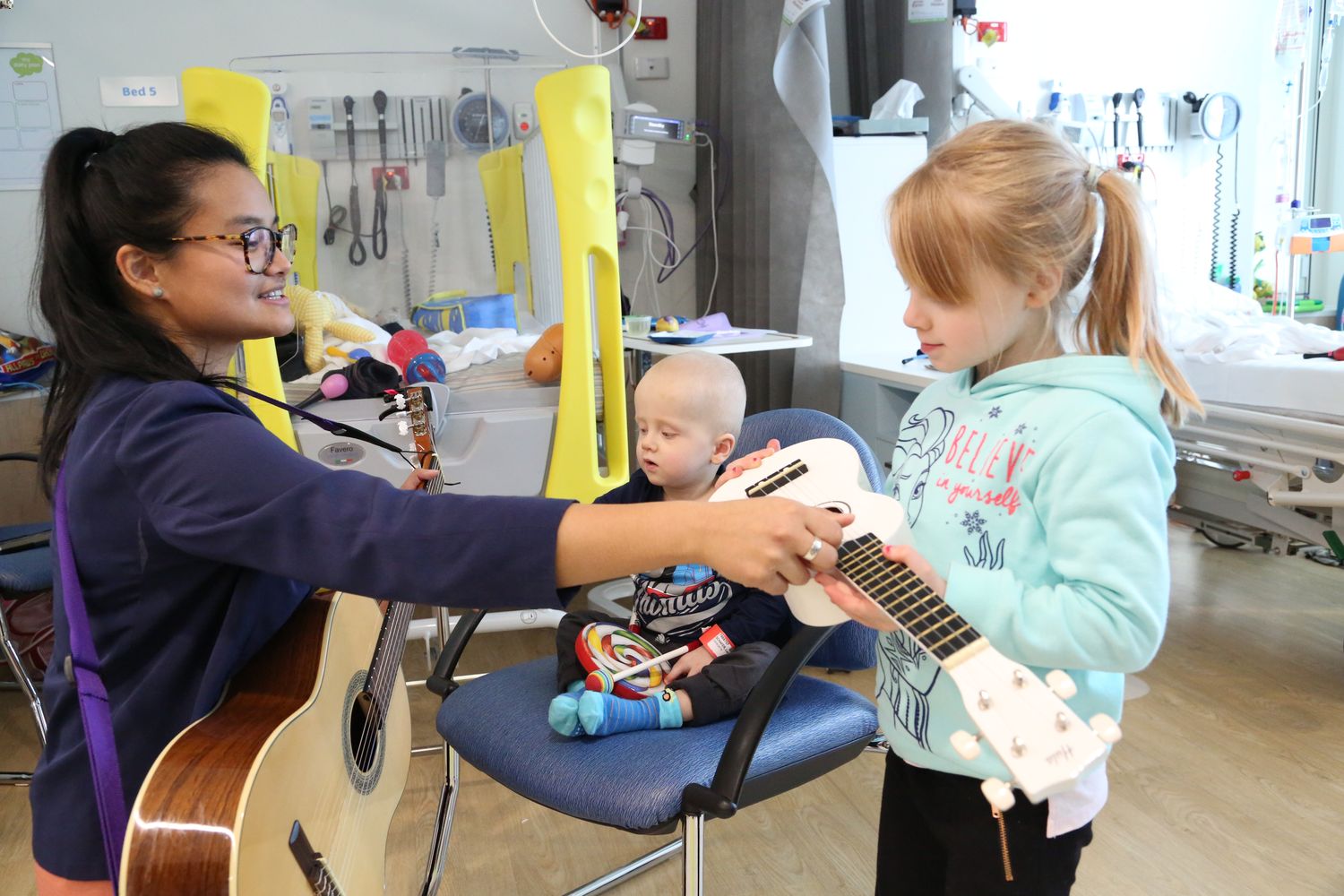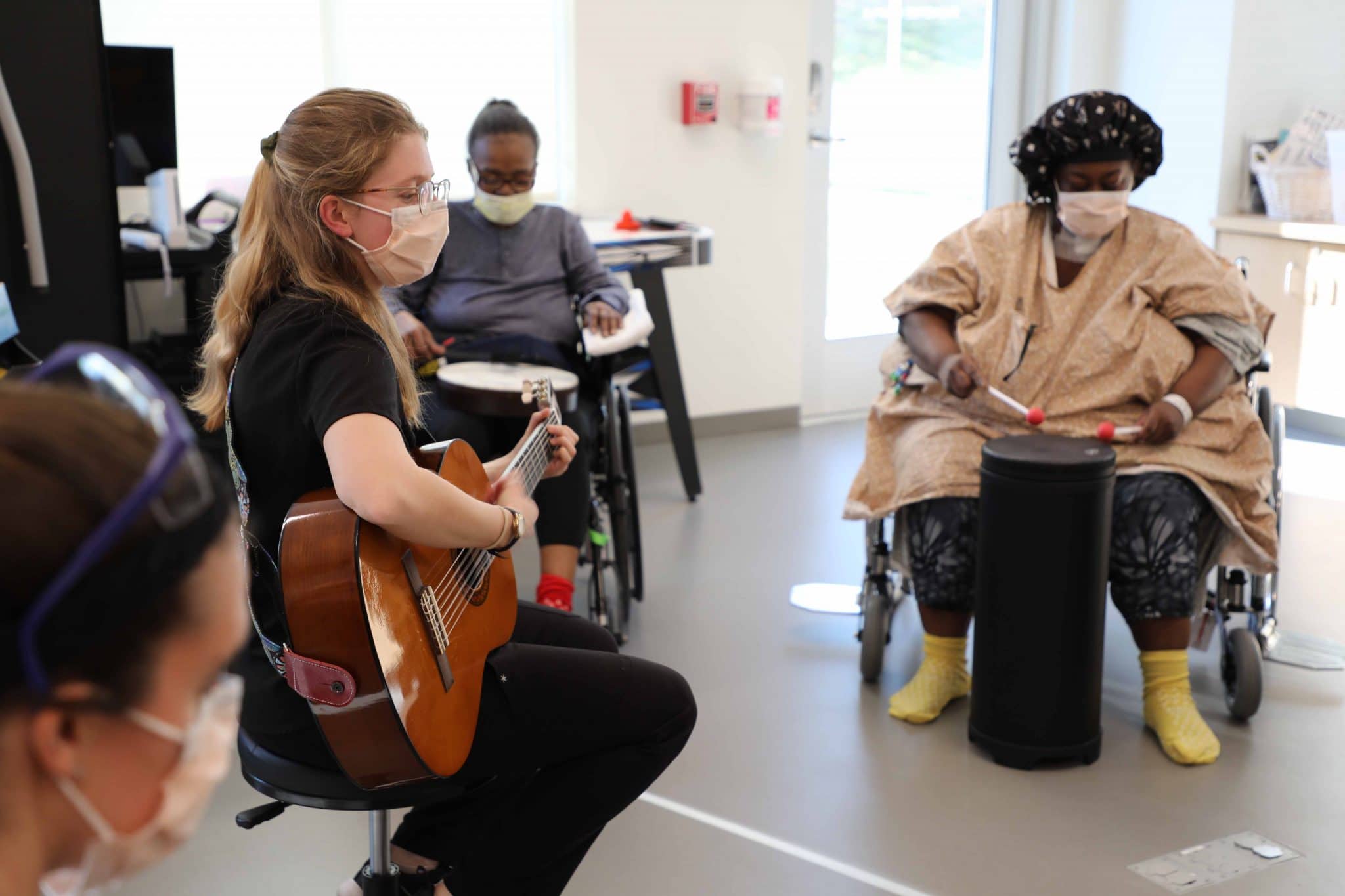Home>Events & Info>Music Therapy>How To Use Music Therapy In Emergency Departments


Music Therapy
How To Use Music Therapy In Emergency Departments
Published: February 2, 2024
Learn how to effectively incorporate music therapy in emergency departments to improve patient outcomes. Discover the power of music as a therapeutic intervention.
(Many of the links in this article redirect to a specific reviewed product. Your purchase of these products through affiliate links helps to generate commission for AudioLover.com, at no extra cost. Learn more)
Table of Contents
- Introduction
- Overview of Music Therapy
- Benefits of Music Therapy in Emergency Departments
- Implementation of Music Therapy in Emergency Departments
- Training and Qualifications for Music Therapists
- Case Studies: Successful Applications of Music Therapy in Emergency Departments
- Challenges and Limitations of Music Therapy in Emergency Departments
- Ethical Considerations in Music Therapy
- Conclusion
- References
Introduction
Music therapy is an innovative and effective approach that utilizes the power of music to promote healing and improve overall well-being. It is a holistic practice that combines the elements of music, psychology, and therapy to address the physical, emotional, and cognitive needs of individuals. Over the years, music therapy has gained recognition and popularity in various healthcare settings, including emergency departments.
In emergency departments, where the atmosphere can be stressful and overwhelming for patients and their families, music therapy offers a valuable tool to alleviate anxiety, reduce pain, and provide emotional support. By incorporating carefully selected music interventions, music therapists can create a calm and soothing environment, leading to better patient experiences and improved clinical outcomes.
Music therapy is not limited to playing background music or providing entertainment. It involves the active participation of the patient and the therapist, utilizing various techniques such as singing, playing instruments, songwriting, and improvisation. This active involvement allows patients to express their emotions, enhance their coping skills, and regain a sense of control during their time in the emergency department.
Furthermore, music has a profound impact on the brain and can stimulate positive physiological responses. It can activate the release of endorphins, which are natural painkillers, and reduce the production of stress hormones like cortisol. The rhythmic and melodic elements of music can also promote relaxation, regulate heart rate and blood pressure, and induce a state of calmness.
In this article, we will explore the benefits of music therapy in emergency departments, discuss its implementation strategies, highlight the training and qualifications required for music therapists, present case studies showcasing successful applications, and examine the challenges and limitations that may arise. By understanding the potential of music therapy in emergency departments, we can foster a greater appreciation for this unique therapeutic approach and pave the way for its wider integration within healthcare systems.
Overview of Music Therapy
Music therapy is a specialized healthcare profession that utilizes music as a therapeutic tool to address physical, emotional, cognitive, and social needs of individuals of all ages. It is based on the understanding that music has a unique ability to evoke emotions, create connections, and facilitate communication.
Music therapists are trained professionals who hold a bachelor’s or master’s degree in music therapy. They possess strong musical skills and knowledge, as well as a deep understanding of human behavior and psychology. They work in collaboration with other healthcare professionals to develop individualized treatment plans that incorporate music-based interventions into the patient’s care.
Music therapy interventions may include listening to music, singing, playing musical instruments, songwriting, improvisation, and movement to music. These activities can be tailored to meet specific therapeutic goals, such as pain management, stress reduction, emotional expression, cognitive stimulation, and social interaction.
In addition to its therapeutic benefits, music therapy has been shown to enhance overall quality of life and well-being. It has the power to uplift mood, improve self-esteem, and provide a sense of empowerment and control. Music therapy also promotes relaxation, aids in emotional regulation, and enhances communication and expression for individuals who may struggle with verbal communication.
Music therapy is a versatile approach that can be utilized in various healthcare settings, including hospitals, rehabilitation centers, nursing homes, and mental health facilities. It is effective for individuals with a wide range of conditions, including but not limited to neurological disorders, developmental disabilities, chronic pain, mental health disorders, and those undergoing medical treatments.
One of the key strengths of music therapy is its ability to reach individuals on multiple levels. It engages the senses, stimulates memories, and creates a safe and non-threatening space for self-expression. This makes it an ideal therapeutic approach for individuals who may find traditional talk therapy challenging or insufficient.
Overall, music therapy offers a unique and powerful approach to healing and well-being. Its holistic nature, combined with the universal appeal of music, makes it a valuable addition to the field of healthcare, providing individuals with a therapeutic experience that goes beyond words alone.
Benefits of Music Therapy in Emergency Departments
Music therapy has demonstrated numerous benefits in the context of emergency departments, where patients often experience high levels of stress, anxiety, and pain. By incorporating music therapy interventions into these settings, healthcare providers can enhance the overall patient experience and improve clinical outcomes. Here are some key benefits of music therapy in emergency departments:
- Reduced anxiety and stress: The soothing and calming effects of music can help alleviate anxiety and stress among patients in the emergency department. Music has the power to distract the mind, promote relaxation, and shift focus away from the stressful environment. This can lead to a decrease in heart rate, blood pressure, and cortisol levels, creating a more comfortable and calming experience for the patients.
- Pain management: Music therapy has been found to be effective in managing pain during medical procedures and interventions. Research suggests that listening to music or playing musical instruments can help divert attention from the pain, enhance pain tolerance, and reduce the need for high doses of pain medication. By incorporating music therapy during painful procedures, emergency departments can promote a more positive and comfortable experience for patients.
- Emotional support: Music has a unique ability to evoke emotions and connect with individuals on an emotional level. In emergency departments, where patients may be facing traumatic events or distressing situations, music therapy can provide emotional support and promote emotional expression. Through songwriting, lyric analysis, or simply listening to music that resonates with their emotions, patients can find solace, validate their feelings, and process their experiences.
- Improved communication and rapport: Music acts as a universal language that transcends barriers and can facilitate communication and connection. In emergency departments, where effective communication and rapport between patients, families, and healthcare providers are crucial, music therapy can bridge those gaps. Singing, playing instruments, or engaging in improvisation can help create a shared experience and build rapport, making patients feel heard, valued, and understood.
- Distraction and normalization: Emergency departments can be unfamiliar and overwhelming environments for patients, especially children. Music therapy provides a means of distraction and normalization, helping to shift the focus away from the medical procedures and the stress of the environment. Engaging in musical activities can create a sense of familiarity, normalcy, and joy, bringing a much-needed respite for patients and their families.
These benefits highlight the valuable role that music therapy plays in emergency departments. By incorporating music therapy into the standard care protocols, healthcare providers can improve patient well-being, enhance the overall patient experience, and support the emotional and psychological needs of individuals during their time in the emergency department.
Implementation of Music Therapy in Emergency Departments
Implementing music therapy in emergency departments requires careful planning, collaboration, and integration into the existing healthcare system. Here are key considerations for successfully integrating music therapy into emergency departments:
- Collaboration with healthcare team: Music therapists should work closely with the healthcare team in the emergency department to identify patients who would benefit from music therapy interventions. Collaboration allows for a coordinated approach to patient care and ensures that music therapy is integrated into the overall treatment plan.
- Assessment and individualized goals: Each patient’s needs are unique, so it is important for music therapists to conduct assessments to understand their specific needs and goals. This assessment helps music therapists tailor interventions to address patients’ physical, emotional, cognitive, and social needs effectively.
- Selection of appropriate interventions: Music therapists select interventions based on the individual patient’s preferences, therapeutic goals, and clinical context. Interventions may include live music playing, guided imagery, music-assisted relaxation, or collaborative songwriting. The choice of intervention depends on the patient’s condition, comfort, and response to different types of music therapy.
- Creating a therapeutic environment: Music therapists should create a calming and supportive environment within the busy emergency department. This may involve playing soft background music, using aromatherapy, and ensuring privacy during music therapy sessions. Creating a therapeutic environment helps patients feel more relaxed and open to therapeutic interventions.
- Involvement of family and caregivers: In emergency departments, involving family members and caregivers in the music therapy process can be beneficial. Family members and caregivers can participate in singing, playing instruments, or engaging in musical activities with the patient. This involvement promotes bonding, reduces anxiety, and provides support and encouragement to the patient.
- Documentation and evaluation: It is essential for music therapists to document the interventions provided and their impact on the patient’s well-being. This documentation serves as a reference for future care and allows for evaluation of the effectiveness of music therapy in emergency department settings. Evaluating outcomes helps refine and improve the music therapy program over time.
- Staff education and awareness: Hospital staff should be educated about the benefits and utilization of music therapy in the emergency department. Staff members should be aware of how music therapy can support patient care and be supportive of integrating music therapy into the standard care protocols. This education and awareness help foster a collaborative and supportive environment for music therapy implementation.
By following these implementation strategies, emergency departments can effectively integrate music therapy into their standard care protocols, providing patients with a more holistic and person-centered approach to their healthcare experience.
Training and Qualifications for Music Therapists
Music therapy is a specialized field that requires specific training and qualifications. Music therapists undergo rigorous education and practical training to develop the necessary skills and knowledge to practice effectively. Here is an overview of the training and qualifications required for music therapists:
- Educational requirements: Music therapists typically hold a bachelor’s degree or higher in music therapy from an accredited university or college. The degree program includes coursework in music theory, music therapy techniques, psychology, anatomy, physiology, and research methods. Some music therapists may pursue advanced degrees, such as a master’s degree or a Ph.D., to further specialize in specific areas or advance their career.
- Clinical training: Alongside academic coursework, music therapy students undergo supervised clinical training. This training consists of hands-on experience working with diverse populations in various healthcare settings, including hospitals, rehabilitation centers, mental health facilities, and private practice. Clinical training allows students to apply theoretical knowledge, develop practical skills, and gain confidence in their ability to deliver effective music therapy interventions.
- Certification and licensure: After completing the required education and clinical training, music therapists have the option to pursue professional certification. The Certification Board for Music Therapists (CBMT) offers the board certification credential, which requires passing a standardized exam. Some states also require licensure to practice as a music therapist. Licensure requirements vary by state but often include a combination of education, clinical training, and passing a state-specific licensing exam.
- Continuing education: Music therapists are encouraged to engage in continuing education to stay updated with the latest research, techniques, and advancements in the field. Continuing education may involve attending workshops, conferences, webinars, and pursuing advanced certifications or specialty training. This ongoing professional development ensures that music therapists maintain competence and provide high-quality care to their clients.
- Professional organizations: Music therapists can join professional organizations such as the American Music Therapy Association (AMTA) to connect with other professionals, access resources, and stay informed about industry developments. These organizations provide a platform for networking, advocacy, and continuing education opportunities, further enhancing the professional growth and development of music therapists.
Music therapists play a critical role in healthcare settings, including emergency departments, by utilizing their specialized knowledge of music therapy techniques, understanding of human behavior, and musical skills to address the physical, emotional, and cognitive needs of their clients. The training and qualifications required for music therapists ensure they are equipped to deliver effective and evidence-based music therapy interventions.
Case Studies: Successful Applications of Music Therapy in Emergency Departments
Several case studies have highlighted the successful applications of music therapy in emergency departments, showcasing the positive impact it can have on patients’ well-being and overall experience. Here are a few examples:
- Case Study 1: Pediatric Patient: A 7-year-old child arrives at the emergency department with a broken arm and is experiencing anxiety and distress. The music therapist engages the child in a music therapy session, using familiar songs and instruments. Through playing the piano and singing, the child’s anxiety decreases, and the focus shifts from pain to enjoyment. The child’s mood improves, and the session provides a distraction from the medical procedure, allowing for easier administration of care.
- Case Study 2: Trauma Patient: A patient is brought to the emergency department after a severe car accident. The patient is in a state of shock and is struggling with pain, fear, and emotional distress. The music therapist provides live calming music, using soothing melodies and rhythm. The patient’s heart rate and blood pressure decrease, and the patient reports feeling more relaxed and less pain. The music therapy session helps the patient cope with the trauma and initiates the healing process.
- Case Study 3: Mental Health Crisis: A patient arrives at the emergency department in a mental health crisis, experiencing heightened agitation and anxiety. The music therapist assesses the patient’s needs and creates a personalized music therapy intervention plan. Through improvisation and songwriting, the patient is able to express their emotions and experiences, leading to a sense of relief and catharsis. The session also helps regulate the patient’s emotions, leading to a more stable and calm state.
- Case Study 4: Pain Management: An elderly patient presents with acute and severe pain in the emergency department. The music therapist employs music-assisted relaxation techniques, combining soft music, guided imagery, and deep breathing exercises. As the patient engages with the music therapy intervention, their perception of pain decreases, enabling them to better manage discomfort without relying solely on medication. The patient leaves the emergency department with a more positive pain management experience.
These case studies illustrate the power of music therapy as a complementary intervention in emergency departments. They demonstrate the ability of music therapy to reduce anxiety, contribute to pain management, provide emotional support, and enhance the overall well-being of patients in challenging and distressing situations.
As these case studies suggest, music therapy holds promise as a valuable tool within the realm of emergency medicine. By incorporating music therapy into emergency department protocols, healthcare providers can support and enhance patient care, improving experiences and outcomes for individuals in need of urgent medical attention.
Challenges and Limitations of Music Therapy in Emergency Departments
While music therapy offers numerous benefits in emergency departments, there are also several challenges and limitations that need to be considered. These include:
- Time constraints: Emergency departments are fast-paced environments, where healthcare providers often face time constraints and must prioritize immediate medical interventions. This limited time availability can make it challenging for music therapists to provide extensive and ongoing music therapy sessions to patients.
- Emergency conditions: In emergency departments, patients may present with acute and life-threatening conditions, making it difficult to fully engage in music therapy interventions. Urgent medical interventions take priority, and the patient’s condition may not allow for the optimal utilization of music therapy techniques.
- Patient preferences and cultural considerations: Music is a highly personal and subjective experience, and not all patients may respond positively to music therapy. Cultural factors, personal preferences, and past experiences with music may influence patients’ receptiveness to music therapy interventions. It is important for music therapists to be sensitive to these factors and adapt their approach accordingly.
- Staff awareness and support: Integrating music therapy into emergency departments requires staff education and awareness of its benefits. It is essential for healthcare providers to understand and support the utilization of music therapy as a complementary approach to patient care. Without organizational support and understanding, the implementation of music therapy may face challenges.
- Limited resources: Some emergency departments may face limitations in terms of resources, including access to qualified music therapists, musical instruments, and appropriate facilities for music therapy sessions. These resource constraints can impede the widespread implementation of music therapy in emergency departments.
- Evaluation and research: Although there is a growing body of evidence supporting the effectiveness of music therapy, more research is needed to further establish its efficacy in emergency department settings. Robust evaluation and research can help build a stronger case for the integration of music therapy into standard emergency department care protocols.
Despite these challenges and limitations, music therapy continues to show promise in emergency departments. By addressing these obstacles through increased awareness, interdisciplinary collaboration, and further research, the utilization of music therapy can be optimized, enhancing the experience and outcomes for patients in these critical healthcare settings.
Ethical Considerations in Music Therapy
When practicing music therapy, professionals must uphold ethical standards to ensure the well-being and autonomy of their clients. Here are some important ethical considerations to keep in mind in the field of music therapy:
- Confidentiality: Music therapists have a duty to protect the privacy and confidentiality of their clients. They must obtain informed consent and ensure that any personal or sensitive information shared during the therapy sessions remains confidential, unless required by law or if there is a risk of harm to the client or others.
- Professional boundaries: Establishing and maintaining appropriate professional boundaries is essential in music therapy. Therapists must adhere to clear and ethical boundaries to ensure a professional and therapeutic relationship with their clients. This includes avoiding dual relationships, maintaining objectivity, and refraining from engaging in personal relationships with clients.
- Cultural competence and inclusivity: Music therapists need to be culturally competent and respectful of diversity in order to provide effective and inclusive care. They should understand and respect the cultural, spiritual, and personal beliefs of their clients, and adapt their interventions accordingly to ensure sensitivity and avoid harm.
- Informed consent: Prior to initiating music therapy, therapists must inform clients about the nature of the therapy, its goals, and potential risks or benefits. Clients have the right to make informed decisions about their participation in music therapy and should be given the opportunity to ask questions and give their consent or refusal for treatment.
- Professional development and competence: Music therapists have a responsibility to maintain their professional competence and engage in continued learning. They should participate in continuing education, seek supervision, and stay updated with current research and best practices in order to provide the highest standard of care to their clients.
- Collaborative decision-making: Music therapists must involve their clients in the treatment planning process and respect their autonomy. They should collaborate with clients, their families, and interdisciplinary teams to develop goals and interventions that align with the client’s preferences, needs, and values.
- Awareness of personal biases and limitations: Music therapists should be aware of their own personal biases, limitations, and potential countertransference that could impact their therapeutic relationships and judgment. They must strive for self-awareness, seek supervision or consultation when needed, and engage in ongoing self-reflection to ensure the best interests of their clients.
Adhering to these ethical considerations fosters trust, promotes a safe and respectful therapeutic environment, and upholds the principles of beneficence, autonomy, and non-maleficence in music therapy practice. By maintaining high ethical standards, music therapists can provide effective and ethical care to their clients, fostering positive therapeutic outcomes.
Conclusion
Music therapy is a powerful and versatile tool that has shown tremendous potential in enhancing the care provided in emergency departments. By incorporating music therapy interventions, healthcare providers can address the physical, emotional, and cognitive needs of patients, leading to improved experiences and outcomes.
Throughout this article, we have explored the benefits of music therapy in emergency departments, including its ability to reduce anxiety and stress, manage pain, provide emotional support, and facilitate communication. We have also discussed the implementation strategies, training and qualifications for music therapists, and the ethical considerations that should guide their practice.
While music therapy in emergency departments faces challenges such as time constraints, resource limitations, and the need for staff education, these barriers can be overcome with increased awareness, collaboration, and research. The case studies presented have demonstrated the positive impact of music therapy interventions on patients’ well-being and overall healthcare experience.
In conclusion, music therapy offers a unique and effective approach to enhance the care provided in emergency departments. By integrating music therapy into the standard care protocols, healthcare providers can create a more holistic and person-centered approach, addressing the physical, emotional, and psychological needs of patients. Through ongoing research, education, and collaboration, music therapy can continue to play a valuable role in emergency medicine, supporting patients and their families during critical times and promoting healing and well-being.
References
- American Music Therapy Association (AMTA). (n.d.). Retrieved from https://www.musictherapy.org/
- Bradt, J., Dileo, C., Potvin, N. (2013). Music for stress and anxiety reduction in coronary heart disease patients. The Cochrane Database of Systematic Reviews, 12(12), CD006577. doi: 10.1002/14651858.CD006577.pub3
- Großekathöfer, U., Raichle, S., Heinz, A., & Schmaus, M. (2020). The effects of music therapy in patients with high anxiety undergoing PET/CT: A pilot study. European Journal of Nuclear Medicine and Molecular Imaging, 47(3), 792-802. doi: 10.1007/s00259-019-04519-0
- Madson, L., & Silverman, M. J. (2010). Music therapy in the emergency room: Testing the effects of live music on patient pain, anxiety, and frustration. Arts in Psychotherapy, 37(5), 387-390. doi: 10.1016/j.aip.2010.08.002
- Miami Children’s Hospital. (n.d.). Music Therapy. Retrieved from https://www.nicklauschildrens.org/patients-and-families/support-and-resources/patient-services/music-therapy
- Paterson, C., Bradt, J., Dileo, C., & Magill, L. (2011). Music interventions for improving psychological and physical outcomes in cancer patients. The Cochrane Database of Systematic Reviews, 8(8), CD006911. doi: 10.1002/14651858.CD006911.pub2
- Raglio, A., & Oasi, O. (2015). Music therapy for patients with neuropsychiatric disorders. Frontiers in Psychology, 6, 1692. doi: 10.3389/fpsyg.2015.01692
- University of Michigan Rogel Cancer Center. (n.d.). Music Therapy at the Rogel Cancer Center. Retrieved from https://www.rogelcancercenter.org/support-services/songs-of-lovehope/rogel-music-therapy
Please note that the above references are for illustrative purposes only. It is important to consult academic and professional literature for an extensive list of relevant and up-to-date resources on music therapy in emergency departments.











